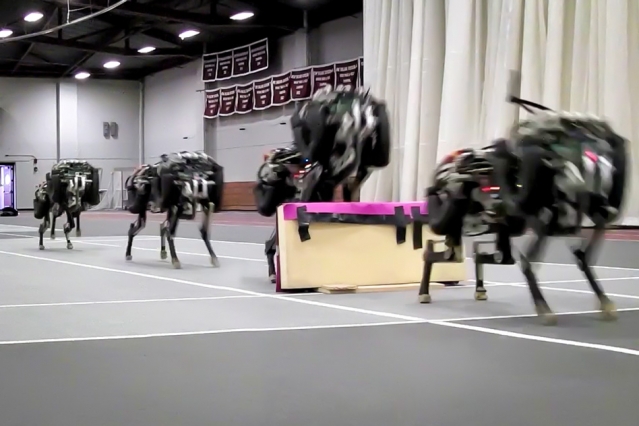What MIT’s robotic cheetah has just achieved is as impressive as it is scary—researchers at the prestigious technology university have trained a robot to see and jump hurdles as it runs, making it the first four-legged bot to run and jump obstacles autonomously.

During tests, the cheetah robot successfully cleared obstacles as high as 18 inches tall (more than half its own height) while maintaining an average running speed of 5 miles per hour.
“A running jump is a truly dynamic behavior,” says Sangbae Kim, an assistant professor of mechanical engineering at MIT who worked with colleagues to develop this impressive piece of machinery. “You have to manage balance and energy, and be able to handle impact after landing. Our robot is specifically designed for those highly dynamic behaviors.”
A bit more specifically, in order to achieve a running jump, the robot first plans out its path. As it detects an approaching obstacle, it estimates the object’s height and distance. Armed with this information, the robot then gauges the best position from which to jump, at which point it adjusts its stride to land just short of the obstacle before exerting enough force to push it up and over.

Based on the obstacle’s height, the robot then applies a certain amount of force in order to land safely before resuming its initial pace.

The robot is able to see thanks to its onboard LIDAR system, which uses reflections from a laser to map terrain. With this data on hand, the MIT team developed a three-part algorithm to help the robot plan out its path. With vision and path-planning systems aboard the robot, it has complete autonomous control.
Speaking to the algorithm, its first component enables the robot to detect obstacles and estimate its size / distance. This formula was devised to specifically give the bot the ability to simplify a visual scene, wherein the ground is represented as a straight line, and any obstacles as deviations from that line. This approach allowed the robot an easier time at estimating an obstacle’s height and distance.
Once an obstacle has been detected, the second component of the algorithm is enabled, which allows the robot to adjust its approach while nearing the obstacle. Based on its distance to said obstacle, the algorithm will predict the best position from which to jump in order to safely clear it; it then backtracks from that point to space out how many strides remain, whereupon the system will adjust the bot’s speed up or slow it down in order to reach the optimal jumping off point.
This approach adjustment algorithm, if you will, runs on the fly, so as to optimize the bot’s stride with every step. The whole process takes about 100 milliseconds to complete, which is about half the time of a single stride.
When the cheetah reaches the jumping-off point, the third component of the algorithm kicks in to determine its jumping trajectory. This is based on the obstacle’s height and robot’s speed. Ultimately, it determines the amount of force the robot’s electric motors should exert in order for the cheetah to safely launch over the obstacle.
Worth noting is that this algorithm does not provide an optimal jumping control—just the most practical one.
“If you want to optimize for, say, energy efficiency, you would want the robot to barely clear the obstacle—but that's dangerous, and finding a truly optimal solution would take a lot of computing time,” Kim says. “In running, we don't want to spend a lot of time to find a better solution. We just want one that's feasible.”
So, sometimes the cheetah may need to jump much higher than it really needs to. Kim says that’s fine though: “We're too obsessed with optimal solutions. This is one example where you just have to be good enough, because you're running, and have to make a decision very quickly.”
The cheetah has been tested on both a treadmill as well as a track. Per the former, the treadmill was about 4 meter long, which gave the bot about 1 meter in which to detect an obstacle and plan out a jump. After a couple of runs, the team gathered the data and reported the cheetah had cleared about 70% of its hurdles.
When put on a track, the cheetah robot performed much, much better, as it had more space and time to see upcoming obstacles. In these runs, the robot cleared 90% of its obstacles.
Check the cheetah robot out in the video below:
Kim and the rest of the MIT researchers will demonstrate the cheetah’s running jump at the DARPA Robotics Challenge this June. They will also present a paper that details the bot’s autonomous system in July at the conference Robotics: Science and Systems.
Via MIT
Advertisement
Learn more about MIT





